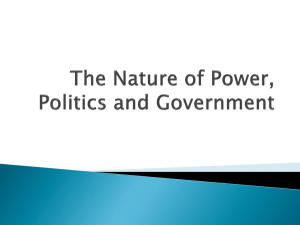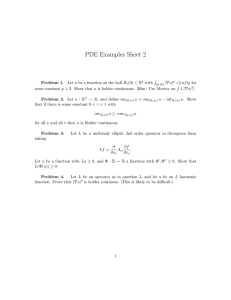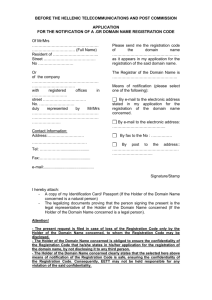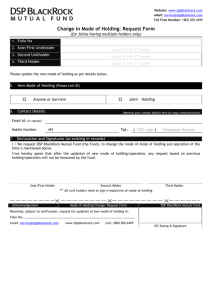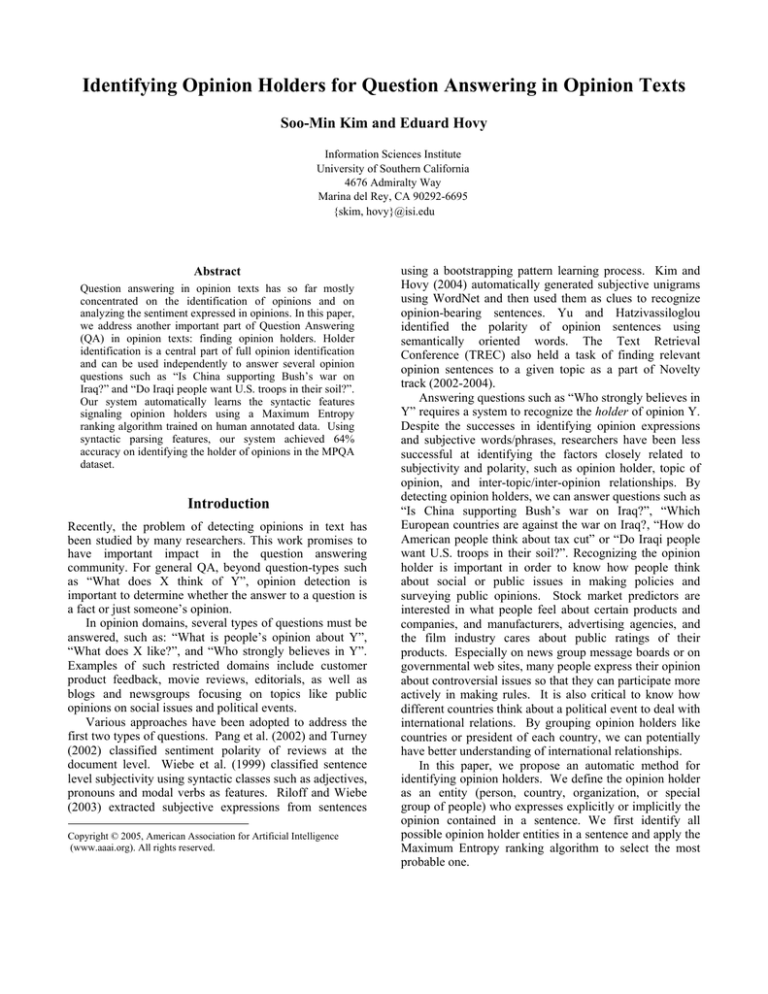
Identifying Opinion Holders for Question Answering in Opinion Texts
Soo-Min Kim and Eduard Hovy
Information Sciences Institute
University of Southern California
4676 Admiralty Way
Marina del Rey, CA 90292-6695
{skim, hovy}@isi.edu
Abstract
Question answering in opinion texts has so far mostly
concentrated on the identification of opinions and on
analyzing the sentiment expressed in opinions. In this paper,
we address another important part of Question Answering
(QA) in opinion texts: finding opinion holders. Holder
identification is a central part of full opinion identification
and can be used independently to answer several opinion
questions such as “Is China supporting Bush’s war on
Iraq?” and “Do Iraqi people want U.S. troops in their soil?”.
Our system automatically learns the syntactic features
signaling opinion holders using a Maximum Entropy
ranking algorithm trained on human annotated data. Using
syntactic parsing features, our system achieved 64%
accuracy on identifying the holder of opinions in the MPQA
dataset.
Introduction
Recently, the problem of detecting opinions in text has
been studied by many researchers. This work promises to
have important impact in the question answering
community. For general QA, beyond question-types such
as “What does X think of Y”, opinion detection is
important to determine whether the answer to a question is
a fact or just someone’s opinion.
In opinion domains, several types of questions must be
answered, such as: “What is people’s opinion about Y”,
“What does X like?”, and “Who strongly believes in Y”.
Examples of such restricted domains include customer
product feedback, movie reviews, editorials, as well as
blogs and newsgroups focusing on topics like public
opinions on social issues and political events.
Various approaches have been adopted to address the
first two types of questions. Pang et al. (2002) and Turney
(2002) classified sentiment polarity of reviews at the
document level. Wiebe et al. (1999) classified sentence
level subjectivity using syntactic classes such as adjectives,
pronouns and modal verbs as features. Riloff and Wiebe
(2003) extracted subjective expressions from sentences
Copyright © 2005, American Association for Artificial Intelligence
(www.aaai.org). All rights reserved.
using a bootstrapping pattern learning process. Kim and
Hovy (2004) automatically generated subjective unigrams
using WordNet and then used them as clues to recognize
opinion-bearing sentences. Yu and Hatzivassiloglou
identified the polarity of opinion sentences using
semantically oriented words. The Text Retrieval
Conference (TREC) also held a task of finding relevant
opinion sentences to a given topic as a part of Novelty
track (2002-2004).
Answering questions such as “Who strongly believes in
Y” requires a system to recognize the holder of opinion Y.
Despite the successes in identifying opinion expressions
and subjective words/phrases, researchers have been less
successful at identifying the factors closely related to
subjectivity and polarity, such as opinion holder, topic of
opinion, and inter-topic/inter-opinion relationships. By
detecting opinion holders, we can answer questions such as
“Is China supporting Bush’s war on Iraq?”, “Which
European countries are against the war on Iraq?, “How do
American people think about tax cut” or “Do Iraqi people
want U.S. troops in their soil?”. Recognizing the opinion
holder is important in order to know how people think
about social or public issues in making policies and
surveying public opinions. Stock market predictors are
interested in what people feel about certain products and
companies, and manufacturers, advertising agencies, and
the film industry cares about public ratings of their
products. Especially on news group message boards or on
governmental web sites, many people express their opinion
about controversial issues so that they can participate more
actively in making rules. It is also critical to know how
different countries think about a political event to deal with
international relations. By grouping opinion holders like
countries or president of each country, we can potentially
have better understanding of international relationships.
In this paper, we propose an automatic method for
identifying opinion holders. We define the opinion holder
as an entity (person, country, organization, or special
group of people) who expresses explicitly or implicitly the
opinion contained in a sentence. We first identify all
possible opinion holder entities in a sentence and apply the
Maximum Entropy ranking algorithm to select the most
probable one.
Identifying opinion holders is difficult especially when
the opinion sentence contains more than one likely holder
entity. In the example sentence “Russia’s defense minister
said Sunday that his country disagrees with the U.S. view
of Iraq, Iran and North Korea as an ‘axis of evil’”,
candidate holders for the reported opinion “disagrees with
the U.S. view” are “Russia”, “Russia’s defense minister”,
“U.S.”, “Iraq”, “Iran”, “North Korea”. Another difficult
problem occurs when there is more than one opinion in a
sentence. In that case, we have to find the right holder for
each opinion. For example, in “In relation to Bush’s axis
of evil remarks, the German Foreign Minister also said,
Allies are not satellites, and the French Foreign Minister
caustically criticized that the United States’ unilateral,
simplistic worldview poses a new threat to the world”, “the
German Foreign Minister” should be the holder for the
opinion “Allies are not satellites” and “the French Foreign
Minister” should be the holder for “caustically criticized”.
This paper is organized as follows. In the next section,
we introduce the data we used for our study. We then
describe our machine learning approach with an
explanation of the feature selection. We report system
experiments and results and conclude in the last section.
Approach
Since more than one opinion may be expressed in a
sentence, it is not enough simply to pick one holder per
sentence. We have to find an opinion holder for each
opinion expression. For example, in a sentence “A think
B’s criticism of T is wrong”, B is the holder of “the
criticism of T”, whereas A is the person who has an
opinion that B’s criticism is wrong. Therefore, we define
our task as finding an opinion holder, given an opinion
expression in a sentence. Our earlier work (Kim and Hovy,
2004) focused on identifying opinion expressions within
text. We employ that system in tandem with the one
described here.
Data
As training data, we used the MPQA1 corpus (Wiebe et al.,
2003) that contains news articles manually annotated by 5
trained annotators using an annotation scheme for
opinions. This corpus consists of 10657 sentences from
535 documents, annotated for four different aspects: agent,
expressive-subjectivity, on, and inside.
Expressivesubjectivity marks words and phrases that indirectly
express a private state that is defined as a term for
opinions, evaluations, emotions, and speculations. On
annotation marks speech events and direct expressions of
private states. Both of them have strength attributes that
indicate the strength of private state. For our task, we only
selected expressions with high strength (high or extreme)
since expression with low strength will likely have lower
inter-annotator agreement (Wilson and Wiebe, 2003)2. As
for the holder, we use the agent of the selected private
states or speech events. Table 1 shows an example of the
annotation. In this example, we consider the expression
“the U.S. government ‘is the source of evil’ in the world”
with an expressive-subjectivity tag as an opinion of the
holder “Iraqi Vice President Taha Yassin Ramadan” since
it is annotated with the strength “extreme.”
1
http://www.cs.pitt.edu/~wiebe/pubs/ardasummer02/
Expressive-subjectivity with strength of high or extereme is
reported to have 0.88 inter-annotator agreement, whereas
expressive-subjectivity with strength of medium, high, or extreme
has only 0.80.
2
Sentence
Iraqi Vice President Taha Yassin
Ramadan, responding to Bush’s ‘axis
of evil’ remark, said the U.S.
government ‘is the source of evil’ in
the world.
Expressive
subjectivity
the U.S. government ‘is the source of
evil’ in the world
Strength
Extreme
Source
Iraqi Vice President Taha Yassin
Ramadan
Table 1. Annotation example.
Maximum Entropy Ranking
To learn opinion holders automatically, we use Maximum
Entropy.
Maximum Entropy models implement the
intuition that the best model is the one that is consistent
with the set of constraints imposed by the evidence but
otherwise is as uniform as possible (Berger et al. 1996).
There are two ways to model the problem with ME:
classification and ranking. Classification allocates each
holder candidate to one of a set of predefined classes while
ranking selects a single candidate as answer. This means
that classification modeling3 can select many candidates as
answers as long as they are marked as true, and does not
select any candidate if every one is marked as false. In
contrast, ranking always selects the most probable
candidate as an answer, which suits our task better. Our
earlier experiments showed poor performance with
classification modeling, an experience also reported for the
question answering task (Ravichandran et al. 2003).
We modeled the problem to choose the most probable
candidate that maximizes a given conditional probability
distribution, given a set of holder candidates
h 1 h 2 . . . h N and opinion expression e. The conditional
3
In our task, there are two classes, holder or not, in classification
modeling.
Sentence
: w1 w2 w3 w4 w5 w6 w7 w8 w9 … wn
Opinion expression <E> :
w6 w7 w8
given
Candidate
holder
selection
… w2 ... w4 w5 w6 w7 w8 … w11 w12 w 13 … w 18 … w 23 w 24 w 25 ..
C1
C2
<E>
C3
C4
C5
Feature
extraction:
Parsing
C1
C2
Rank the candidates by
ME model
<E>
C3
C4
C5
1.C1 2. C5 3.C3 4.C2 5.C4
Pick the best candidate as a holder
“he” refers to. If a more specific entity than the pronoun
appears in the sentence, we should pick it by not letting
ME consider pronoun holders. Second, for most cases
with a pronoun as the holder, the referent named entity
appears in some previous sentence. Solving the coreference resolution problem is beyond the boundary of
our work. As a result, we considered only named entities
and noun phrases as holder candidates.
Table 2 shows an example of all noun phrase and named
entity holder candidates selected for the sentence in Table
1. We use BBN’s named entity tagger IdentiFinder to
collect named entities and Charniak’s parser to extract
noun phrases.
Candidate
Taha Yassin Ramadan
Bush
U.S.
Bush’s
Bush’s ‘axis of evil’ remark
the world
evil’
evil’ in the world
The source
The source of evil’ in the world
The U.S. government
Iraqi Vice President Taha Yassin
Ramadan
C1
Figure 1. Overall system architecture.
probability P h h 1 h 2 . . . h N , e
can be calculated
based on K feature functions f k h , h 1 h 2 . . . h N , e .
We write a decision rule for the ranking as follows:
xam
hˆ =
=
a rg
h
[P(h | {h1 h2 ... h N }, e)]
K
a rg
h
[ ∑ λk f k (h, {h1 h2 ... h N }, e) ]
k =1
Each
is a model parameter indicating the weight for
k
its feature function.
Holder Candidate
Intuitively, one would expect most opinion holders to be
named entities (PERSON or ORGANIZATION).
However, also common noun phrases can be opinion
holders, such as “the U.S leader”, “Iranian officials”, and
“the Arab and Islamic world”. Sometimes, pronouns like
he, she, and they that indicate a PERSON or it that
indicates an ORGANIZATION or country can be an
opinion holder. In our study, however, we do not consider
pronoun holders for several reasons. First, even if we pick
the correct pronoun holder, say “he”, this does not really
provide the requisite information until we determine what
NP
Table 2: Candidates selected from the sentence in Table
1.
Overall System Architecture
Figure 1 describes our holder identification system. First,
the system generates all possible holder candidates, given a
sentence and an opinion expression <E>. After parsing the
sentence, it extracts features such as syntactic path
information between each candidate <H> and the
expression <E> and a distance between <H> and <E>.
Then it ranks holder candidates according to the score
obtained by the ME ranking model. Finally the system
picks the best candidate with a highest score. The
following sections describe how to select holder candidates
and how to select features for the training model.
Type
PERSON
PERSON
LOCATION
NP
NP
NP
NP
NP
NP
NP
NP
Feature Selection
We describe three types of features in this section: full
parsing features, partial parsing features, and others. Our
hypothesis is that there exists a structural relation between
a holder <H> and an expression <E> that can help to
identify opinion holders. This relation may be represented
by lexical level patterns between <H> and <E>, but
anchoring on specific words might run into the data
sparseness problem. For example, if we see the lexical
pattern “<H> recently criticized <E>” in the training data,
it is impossible to match the expression “<H> yesterday
condemned <E>”. To determine how much generalization
is needed beyond the lexical level, and hence to prove our
hypothesis, we selected structural features from a deep
parse, a partial parse, and the surface level, and used ME
to compare performances. For deep parsing we used the
Charniak parser and for partial parsing the CASS parser4.
4
http://www.sfs.nphil.uni-tuebingen.de/Staff-Old/abney/#cass
S
NP
VP
ADVP
RB
NP
JJ
also
official
PP
VBD
IN
weighed
NP
on
NNP
POS
China
‘s
IN
NNP
Xinhua
PP
NN
news
NN
agency
in
NP
sunday
NNP
Bush
S
.
VP
NP
NP
NNP
S
,
PP
NN
IN
NP
choice
of
NNS
POS
‘s
PP
NP
DT
NN
VBG
words
accusing
VP
of
VBG
president
the
S
IN
orchestrating
public
PP
NP
JJ
NN
opinion
In advance of possible
strikes against the three
countries in an expansion of
the war against terrorism
Figure 2. A parsing example.
Parsing Features
After parsing the sentence, we search for the lowest
common parent node of the words in <H> and <E>
respectively (<H> and <E> are mostly expressed with
multiple words). A lowest common parent node is a nonterminal node in a parse tree that covers all the words in
<H> and <E>. Figure 2 shows a parsed example of a
sentence with the holder “China’s official Xinhua news
agency” and the opinion expression “accusing”. In this
example, the lowest common parent of words in <H> is the
bold NP and the lowest common parent of <E> is the bold
VBG.
We name these nodes Hhead and Ehead
respectively. After finding these nodes, we label them by
subscript (e.g., NPH and VBGE) to indicate they cover <H>
and <E>.
In order to see how Hhead and Ehead are related to each
other in the parse tree, we define another node, HEhead,
that covers both Hhead and Ehead. In the example,
HEhead is S at the top of the parse tree since it covers both
NPH and VBGE. We also label S by subscript as SHE.
To express tree structure for ME training, we extract
path information between <H> and <E>. In the example,
the complete path from Hhead to Ehead is “<H> NP S VP
S S VP VBG <E>”. However, representing each complete
path as a single feature produces so many different paths
with low frequencies that the ME system would learn
poorly. Therefore, we split the path into three parts, as in
Table 3. With this splitting, the system can work when
any of HEpath, Hpath or Epath appeared in the training
data, even if the entire path from <H> to <E> is unseen.
Table 4 summarizes these concepts with two holder
candidate examples in the parse tree of Figure 2. Among
the children nodes of HEhead, we ignore any other nodes
that do not relate to <H> or <E>. But these paths are
sometimes so long that they may still encounter the data
sparseness problem. This motivated us to examine path
generalization. We add another feature that only considers
the top two levels below a child node of HEhead on the
path toward Hhead. With this feature, we can consider the
paths “<H> NPH PPH NPH ” and “<H> NPH NPH PPH VPH
NPH PPH NPH” as the same because they share “PPH NPH”
at the top.
Path
HEpath
From
HEhead
Hpath
Hhead
Epath
Ehead
To
Two children nodes that are also
parents nods of Hhead and
Ehead
Hhead’s ancestor node that is a
child of HEhead
Ehead’s ancestor node that is a
child of HEhead
Table 3. Path definition.
Hhead
Candidate 1
China’s
official
Xinuhua news agency
NPH
Candidate 2
Bush
NNPH
Ehead
HEhead
Hpath
VBGE
SHE
Epath
HEpath
VBGE VPE SE SE VPE
VBGE
VPHE
NNPH NPH NPH
NPH PPH
VBGE VPE SE SE
SHE NPH VPE
VPHE PPH SE
NPH
Table 4. Heads and paths example.
Partial Parsing Features
Full parsing provides rich information about a sentence
structure but it often produces too large and deep parse
trees. It raises a question about the necessity of full
parsing. Therefore, we applied a partial parser and
extracted features from its result to compare its
performance with full parsing. Figure 3 shows a chunk
example of the partial parser.
(c China's official Xinhua news agency also
weighed in Sunday on Bush's choice of words, )
(vgp accusing the president of orchestrating
public opinion in advance of possible strikes
against the three countries in an expansion of the
war against terrorism. )
Figure 3. Partial parsing example.
As features we use the tags of the chunk containing <H>
and of the chunk containing <E>. In the following
example, the chunk tag for the holder “China's official
Xinhua news agency” is c and the tag for the opinion
expression “accusing” is vgp. We also consider whether
<H> and <E> belong to the same chunk.
Other Features
We also include two non-structural features. The first is
the type of the candidate, with values NP, PERSON,
ORGANIZATION, and LOCATION. This feature enables
ME to determine the most probable one among them
automatically. The second feature is the distance between
<H> and <E>, counted in parse tree words. This is
motivated by the intuition that holder candidates tend to lie
closer to their opinion expression. All features are listed in
Table 5.
Experiments and Results
Answer Selection
Choosing an answer (or answers) from multiple holder
candidates is an important issue for training and
evaluating. Even though each opinion expression has been
annotated with a holder in the training and test sentences,
we cannot consider only candidates that match exactly with
the marked holder. In many cases, just part of the holder is
enough for a valid answer. For example, when a holder is
“Michel Sidibe, Director of the Country and Regional
Support Department of UNAIDS”, just “Michel Sidibe” is
also enough to be an answer. Or, in the case “Chief
Minister Dr. Farooq Abdullah”, the title part “Chief
Minister” and the rest “Dr. Farooq Abdullah” are both
acceptable answers along with the whole phrase.
On the other hand, just allowing any holder candidate
that partially matches with the holder does not work. For
example, given a holder “the head of the medical staff of
Amnesty International, Jim West”, noun phrases like “the
head” or “medical staff” are not representative enough for
an answer. If a more proper holder candidate like “Jim
West” exists, we should pick it. In order to generate the
gold standard, we assign each candidate a priority value
first that represents how likely it is to be an answer. Table
6 shows the priority value assignment algorithm.
Features
f1
f2
f3
f4
f5
f6
f7
f8
f9
Description
Type of <H>
HEpath
Hpath
Epath
Distance between <H> and <E>
Top two levels of Hpath
Chunk tag of <E>
Chunk tag of <H>
Whether <E> and <H> are in the
same chunk
Table 5. Features for ME training.
Priority
Condition
1
|Overlaped string| > threshold1 and
|Irrelevant words| < threshold2
2
3
|Overlapped string| > threshold1
|Overlapped string| > 0
Table 6. Priority value assignment algorithm for answer
selection.
We use 0.5 for threshold1, which means we allow a
candidate as an answer in case half of the words in a
holder appear in the candidate as well. With this
threshold, given a holder such as “President Bush”, we
allow both “President” and “Bush” as eligible answers.
However, if a candidate contains many irrelevant words, it
is less likely to be an answer than any candidate that
contains only relevant words. We use threshold2 for this
purpose and assign it 4, since the average number words in
human annotated holders is 3.71.
After assigning these values to candidates, we pick
candidates in priority order as answers. Using this
algorithm, only 155 candidates among the total 1078
candidates in the test data (14%) are picked. This means
that on average 11 candidates are picked by the system for
each case but only 1.58 of them are marked correct on
average. We call this selection method a strict selection.
However, when we accept candidates with any priority
(1,2, or 3), 36% of candidates are marked correct. We call
this a lenient selection. We report experimental results of
both selections below.
Evaluation Result
From the MPQA data described above, we collected 961
pairs of (<E>,<H>) and divided them into a training set of
863 and a test set of 98. We evaluated system performance
by accuracy: the number of times a correct holder was
found divided by the total number of cases.
lenient
strict
strict_top2
baseline
lenient_top2
strict_top3
lenient_top3
f789
f789
f5789
f5789
f15789
f15789
f123456789
f123456789
f13456
f123456
f13456
f12345
f123456
f12346
f12345
f1234
f234
f12346
f15
f1234
f1
0
0.1
0.2
0.3
0.4
0.5
0.6
0.7
0.8
f234
accuracy
f15
Figure 4. Named Entity candidates.
lenient
f5
s trict
f1
baseline
0
f 789
0.1
0.2
0.3
0.4
0.5
0.6
0.7
0.8
0.9
1
accuracy
f5789
f 15789
Figure 6. Accuracy of top 2 and top 3 answers.
f123456789
f 13456
f123456
f 12345
f 12346
f1234
f 234
f15
f1
0
0.1
0.2
0.3
0.4
0.5
0.6
0.7
accuracy
Figure 5. Noun Phrase candidates.
We provided candidate holders for ME choice using two
methods: just named entities or all NPs 5 . Since named
entities constitute only 59% of the correct answers in the
test data, for the named entity evaluation we manually
extracted and used only those sentences. Thus for
evaluation purposes, we picked those 59% for the named
entity candidate selection method but used the whole test
data set for the NP candidate selection.
Figures 4 and 5 report the accuracy of each method.
For notational convenience, we represent each feature by
its index on the axis. The average number of candidates
selected is 2.95 for NE selection and 11 for NP selection.
To evaluate the effectiveness of our system, we set the
baseline as the system choosing the closest candidate to the
expression as a holder without ME decision. This baseline
system performed only 0.39 accuracy (lenient measure)
and 0.22 (strict measure) in Figure 5. Among the 9
5
Noun phrases include named entities.
features, we group f2, f3 and f4 together since they reflect
deep parsing features and group f7, f8 and f9 together as
chunk features for experimental convenience.
As can be seen from the results in Figures 4 and 5,
features other than distance or candidate type helped in
performance. Especially the structural features of parsing,
f2, f3, and f4, improved the performance significantly. We
interpret these results as demonstrating that there exists a
clear syntactic relationship between a holder and an
opinion expression. Another observation we found from
this study is that partial parsing (features f789) does not
adequately capture the holder and expression relationships.
Figure 5 shows that deep parsing features (f234) perform
at 0.57 but partial parsing (f789) perform at only 0.36 in
lenient measure. Similarly, deep parsing features combined
with f1 and f5 perform at 0.62 but partial parsing features
combined with the same features perform at 0.44. Feature
f6 (taking only the top two levels of Hpath) performs
worse than the full path feature (compare f13456 to
f12345).
To evaluate our system more practically, we counted
how many test data found correct answers within top 2 and
top 3 answers system provided instead of just top first
answer. Figure 6 shows accuracy of noun phrase candidate
selection in strict and lenient measure on the whole test
data. Again the structural features helped more than any
other feature, reaching up to 90% of accuracy in lenient
measure.
Table 7 shows the system output of the example in
Figure 2. The system successfully finds the right holder as
the highest ranked answer, and ranks the candidate “Bush”
at the bottom.
Rank
1
2
3
4
5
6
7
8
9
10
11
12
13
14
15
16
17
18
19
20
21
Candidates
China’s official Xinhua
news agency
Xinhua
China’s
China
the president
possible strikes
public opinion
the three countries
Advance
possible strikes against the
three countries
an expansion
the war against terrorism
an expansion of the war
against terrorism
the war
Terrorism
Bush’s choice of words
Sunday
Words
Bush’s choice
Bush’s
Bush
Score
0.053999
0.053972
0.051066
0.051053
0.048306
0.048274
0.048180
0.048172
0.048127
0.048110
0.047937
0.047812
0.047751
0.047595
0.047542
0.044291
0.044136
0.043868
0.043697
0.043073
0.043042
Table 7. System output of the example in Figure 2.
Conclusions
This study describes the automated identification of the
holder of a given opinion expression for question
answering in opinion text domain. The importance of
opinion holder identification was noticed yet it has not
been much studied to date, partly because of the lack of
annotated data. For our study, we extracted from the
MPQA dataset strong opinion expressions on which
annotators highly agreed, and for which the opinion holder
appeared in the same sentence. We used Maximum
Entropy ranking to select the most probable holder among
multiple candidates.
Adopting parsing features
significantly improved system performance. The best
feature combination performed at 64% accuracy.
For future work, we plan to experiment with crosssentence holder identification, in which an opinion holder
and an opinion expression may appear in different
sentences. We also plan to investigate other types of QA
in opinion texts such as automatic topic identification, and
the determination of relationships between topics and
subtopics in opinion-bearing texts.
References
Abney, S. 1997. The SCOL Manual: Version 0.1b.
http://www.sfs.nphil.uni-tuebingen.de/Staff-Old/abney /#cass
Berger, A, S. Della Pietra, and V. Della Pietra. 1996. A Maximum
Entropy Approach to Natural Language Computational
Linguistics 22(1).
Charniak, E. 2000. A Maximum-Entropy-Inspired Parser.
Proceedings of NAACL-2000.
Kim, S. and E.H. Hovy. 2004. Determining the Sentiment of
Opinions. Proceedings of COLING-04.
Mitchell, T. 1997. Machine Learning. McGraw-Hill International
Editions: New York, NY, 143–145.
Och, F.J. 2002. Yet Another MaxEnt Toolkit: YASMET
http://wasserstoff.informatik.rwth-aachen.de/Colleag ues/och/
Pang, B, L. Lee, and S. Vaithyanathan. 2001. Thumbs up? Sentiment
Classification using Machine Learning Techniques. Proceedings
of EMNLP 2002.
Ravichandran, D., E.H. Hovy, and F.J. Och. 2003. Statistical QA —
classifier vs re-ranker: What’s the difference? Proc. of the ACL
Workshop on Multilingual Summarization and Question
Answering.
Riloff , E. and J. Wiebe. 2003. Learning Extraction Patterns for
Subjective Expressions. Proceedings of the EMNLP-03.
Riloff, E., J. Wiebe, and T. Wilson. 2003. Learning Subjective Nouns
Using Extraction Pattern Bootstrapping. Proceedings of CoNLL03
Turney, P. 2002. Thumbs Up or Thumbs Down? Semantic
Orientation Applied to Unsupervised Classification of Reviews.
Proceedings of the 40th Annual Meeting of the ACL, Philadelphia,
417–424.
Wiebe, J., E. Breck, C. Buckley, C. Cardie, P. Davis, B. Fraser, D.
Litman, D. Pierce, E. Riloff, T. Wilson, D. Day, D., and M.
Maybury. 2003. Recognizing and Organizing Opinions Expressed
in the World Press. Proceedings of the AAAI Spring Symposium
on New Directions in Question Answering.
Wiebe, J, R. Bruce, and T. O’Hara. 1999. Development and use of a
gold standard data set for subjectivity classifications. Proc. of the
37th Annual Meeting of the Association for Computational
Linguistics(ACL-99), 246–253.
Wilson, T. and J. Wiebe. 2003. Annotating Opinions in the World
Press. Proceedings of the 4th SIGdial Workshop on Discourse and
Dialogue (SIGdial-03).
Wilson, T. and J. Wiebe. 2003. Annotating Opinions in the World
Press. Proceedings of the ACL SIGDIAL-03.
Yu, H. and V. Hatzivassiloglou. 2003. Towards Answering Opinion
Questions: Separating Facts from Opinions and Identifying the
Polarity of Opinion Sentences. Proceedings of the EMNLP
conference.


